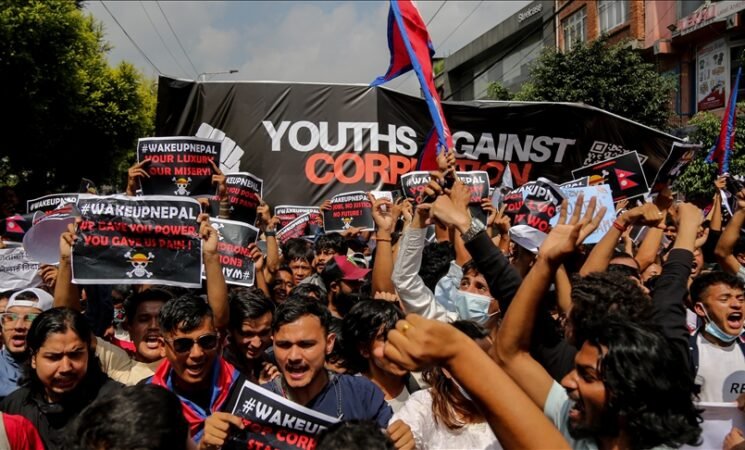27 October 2025, NIICE Commentary
Manasi Sinha & Amreen Ali
Across South Asia’s restless skies, a storm is gathering – and it carries the name of a generation. From Kathmandu’s narrow lanes to Dhaka’s drenched squares, South Asia’s youth are no longer whispering about change; they are engineering it. They have swapped submission for solidarity, despair for digital defiance. In less than three years, three regimes long considered immovable have crumbled – Sri Lanka’s Rajapaksas in 2022, Sheikh Hasina’s 15-year reign in Bangladesh in 2024, and K.P. Sharma Oli’s government in Nepal in 2025. The pattern is neither accidental nor isolated. It signals the arrival of a new political grammar – one written not in party manifestos but in tweets, protests, and collective refusals.
This generation – South Asia’s Gen Z – has begun redrawing the region’s political map. Their uprisings are not mere spasms of anger; they are blueprints for a new political order, where rights, accountability, and transparency are no longer luxuries but non-negotiables. A region long held hostage by dynasties and gerontocracies now stands at the edge of an epochal transition: from loyalty-based politics to rights-based politics, from inheritance to participation.
The Spark Beneath the Storm: What Fuels This New Political Consciousness?
Behind every street march and trending hashtag lies a deeper fatigue – a generation’s disillusionment with promises that never materialized. In Bangladesh, the July 2024 Supreme Court verdict upholding a 30% job quota for descendants of 1971 war veterans ignited the “Monsoon Uprising.” What was framed as homage to history became a monument to nepotism. For a youth population of 32 million, many without jobs or opportunities, the quota system symbolizes the rot of patronage. When students took to Dhaka University’s streets, they were not just protesting a policy – they were indicting a system where lineage triumphed over merit.
In Nepal, a September 2025 government order banning 26 social media platforms triggered an equally explosive reaction. Officially justified as a step against cybercrime, it was perceived as an attempt to muzzle dissent in a nation where nearly 90% of citizens live online. Overnight, the ban disconnected migrant workers from families and silenced digital entrepreneurs, artists, and activists. Within four days, protests erupted under the banner of Hami Nepal, a youth collective whose rallying cry – “Corruption off, not connection!” – captured the essence of the movement: a rejection of elite hypocrisy and a demand for freedom of expression.
These flashpoints – Bangladesh’s quota, Nepal’s ban – are surface cracks in a deeper tectonic fault: an entire generation confronting the contradictions of South Asian democracy. They have grown up in electoral states but not necessarily in democratic societies; they know the ballot but not the right to belong. Their movements are not just protests against injustice, they are assertions of dignity, demands for a new political order grounded in fairness, rights, and access.
Digital Republics: How the Internet Became a Parliament of the People?
Every revolution seeks its medium. For South Asia’s youth, that medium is digital. In Bangladesh’s Monsoon Uprising, Facebook became the forum of the dispossessed. Protesters live-streamed police crackdowns, posted memes mocking corruption, and turned red-filtered protest art into viral symbols of resistance. Hashtags like #BangladeshQuotaReform and #RazakarGovernment unified disparate voices under one defiant narrative: meritocracy over dynasty.
In Nepal too, the state’s ban on social media backfired spectacularly. Young Nepalis circumvented restrictions with VPNs, using TikTok and Telegram to coordinate flash mobs and broadcast the brutality of state repression. Viral clips of ministers’ children flaunting wealth while graduates languished jobless crystallized popular rage. The hashtag #NepoBabies turned generational cynicism into moral indictment. These were not random acts of rebellion; they were acts of political pedagogy. Through digital channels, youth learned to self-organize, fact-check propaganda, and articulate demands rooted in rights: fair access to jobs, freedom of speech, gender and caste equality, and accountability in governance. The hyperconnectivity of this generation dissolves borders. The meme that mocked a Bangladeshi minister’s hypocrisy became an inspiration for Nepali protesters.
Sri Lanka’s Aragalaya livestreams in 2022 taught Bangladesh’s students how to occupy public spaces peacefully; Dhaka’s digital campaigns in turn inspired Kathmandu’s youth to hold decentralized protests. Across the region, social media is no longer merely a tool – it has become an alternative public sphere, a digital republic where grievances translate into collective power.
Blood, Byte, and the Birth of Rights-Based Politics:
The cost of this awakening has been steep. In Bangladesh, 1,400 were killed and more than 11,000 arrested during the 2024 crackdown. Among them were indigenous students, queer activists, and journalists – all groups historically pushed to the margins. In Nepal, 26 young protesters lost their lives in September 2025 as police fired live rounds into the crowd. Hospitals overflowed with wounded teenagers, their blood writing a new social contract on the streets of Kathmandu. Yet even in tragedy, something transformative emerged. The grief that once silenced now mobilizes. Murals of slain students appear across Dhaka, painted with the words “Second Independence.” In Kathmandu, QR-coded candlelight vigils lead to online petitions demanding constitutional reform. Every act of mourning becomes an act of resistance, every loss a brick in the foundation of a new political consciousness. For decades, South Asian politics thrived on charismatic authoritarianism – the strongman leader, the dynastic heir, the promise of development in exchange for dissent. What Gen Z has exposed is the moral bankruptcy of that model. Their protests are not about replacing one ruler with another; they are about rewriting the social contract itself. In this sense, the youth movements are not merely revolutionary, they are constitutional. They seek to resurrect the very essence of democracy: rights as the measure of legitimacy, not lineage. Blood stains these victories, yet it cements transformation. In Sri Lanka, Aragalaya’ s inclusive roar – uniting Tamils, Muslims, Buddhists, and queers – shattered ethnic silos, demanding not just resignations but systemic justice: prosecute economic crimes, end militarized patronage, and ensure food sovereignty. Wickremesinghe's crackdowns exiled talents in a brain drain, but 60 percent of Sri Lankans still pine for the movement's unfulfilled dreams, as per 2023 surveys. Now, under Dissanayake's academics-turned-leaders, the NPP decentralizes power, returns seized lands, and eyes debt relief without pauperizing the masses.
Across South Asia, the youth are alchemizing collective trauma into civic architecture. This Gen Z ethos rejects the mythology of the strongman, exposing the moral vacuum where charisma once masqueraded as competence. Their protests double as classrooms: organizing through Telegram, verifying truth on TikTok, and practicing governance through consensus. They reclaim dignity through demands for fair jobs, free speech, and caste justice – intersectional in vision, pragmatic in pursuit.
From Protest to Politics: Building New Infrastructures of Accountability
Revolutions often stumble at the gates of governance, but South Asia’s new youth movements are determined not to repeat history. Sri Lanka’s Aragalaya ignited in March 2022 — a generation betrayed turning despair into defiance. Hyperinflation, empty fuel stations, and a collapsing rupee fed a peaceful uprising against the Rajapaksas’ corruption and failed policies like synthetic fertilizer ban that gutted rice yields. Colombo's Galle Face Green transformed into GotaGoGama, a vibrant "protest village" where students, farmers, lawyers, and monks-built tents, community kitchens, libraries, and healing spaces. Hashtags like #GoHomeGota surged as live streams mixed song, satire and tear gas. By April, 240 protests flared nationwide; in May, regime loyalists attacked, killing one and triggering counter-riots that burned 40 MPs' homes. Mahinda Rajapaksa resigned that night. On July 9, jubilant crowds occupied the presidential offices – a revolution without vandalism – until security raids on July 22 silenced the movement’s heart. In Bangladesh, the Monsoon Uprising gave birth to the National Citizens’ Party (NCP) in early 2025 – a coalition of activists, academics, and young professionals. Their agenda is simple but radical: abolish political dynasties, introduce transparent hiring, and ensure civic representation. In Nepal, Hami Nepal has refused to become a party, instead choosing to act as a civic watchdog. They publish open-source corruption data, hold online consultations with citizens, and crowdsource draft reforms. Their activism bridges the digital and democracy, proving that governance can be participatory without being partisan. These are not isolated cases; they are laboratories of political reinvention. Across the region, youth collectives are experimenting with cooperative economies, community journalism, and feminist leadership models. They are recording politics to reflect equality, not entitlement.
Nonetheless, the obstacles remain formidable. Bangladesh’s interim government, led by Nobel laureate Muhammad Yunus, struggles to manage strikes and sectarian flare-ups. Nepal’s caretaker administration teeters under military influence. Old political ghosts linger – BNP in Bangladesh, monarchists in Nepal, populists in Sri Lanka – waiting for the youth’s fatigue to turn into disillusionment. This generation’s stamina is digital, decentralized, and deeply moral. They are less interested in seizing power than in decentralizing, transforming governance into a network, not a throne.
Conclusion: The Rise of the Rights Generation
What began as street protests has evolved into a philosophical shift. South Asia’s youth are reimagining democracy not as an inheritance but as a living, negotiable right. The youth uprisings mark a profound democratic reawakening, challenging entrenched hierarchies and populist excesses. They expose the fragility of electoral democracies sustained by dynasty and charisma, replacing them with calls for rights, accountability, and participatory governance. These movements redefine politics as a lived moral practice—digital, decentralized, and inclusive—where activism becomes a pedagogy of citizenship. Yet, their significance lies not just in protest but in proposing new infrastructures of power rooted in transparency and intersectionality. By transforming despair into democratic renewal, South Asia’s youth illuminate both the promise and the perils of reclaiming democracy from within.
Manasi Sinha is a faculty member of International Politics, Easwari School of Liberal Arts, SRM University, India & Amreen Ali is at the Paari School of Business, SRM University AP, India.

